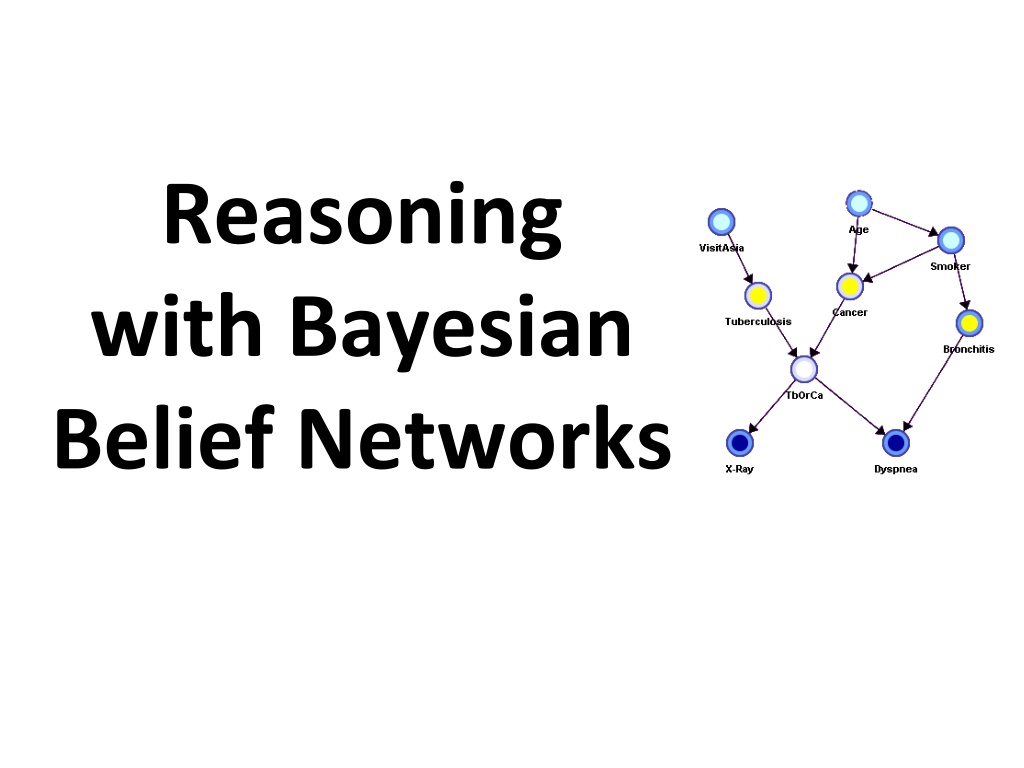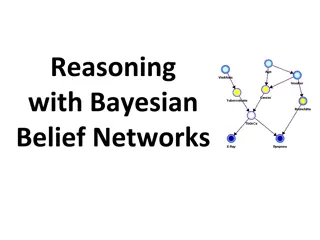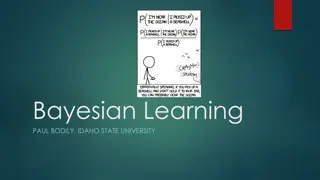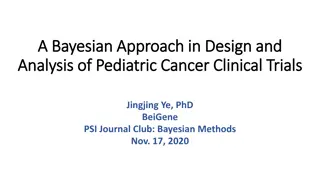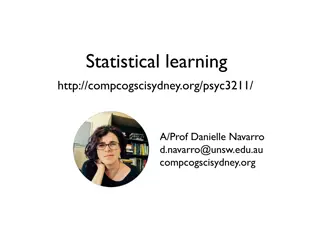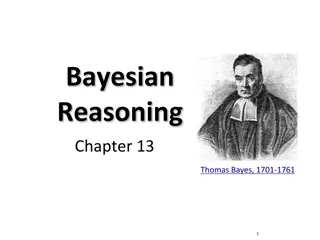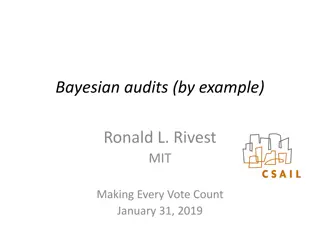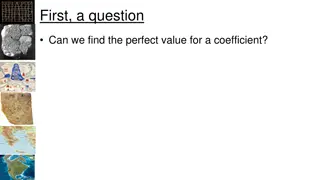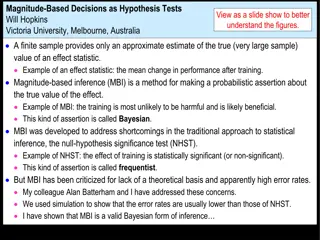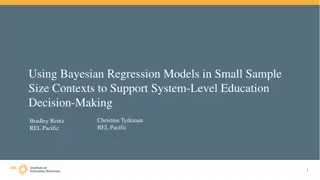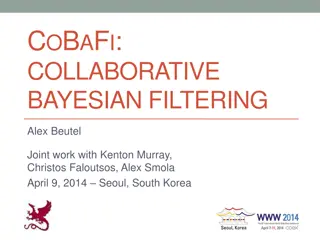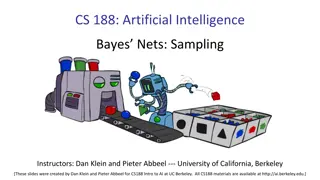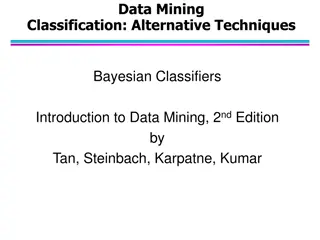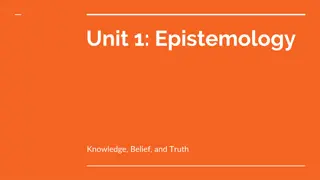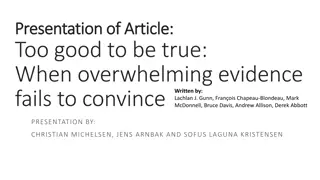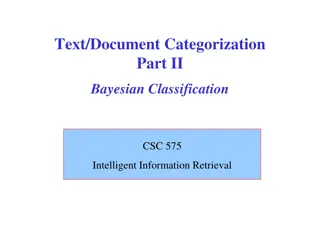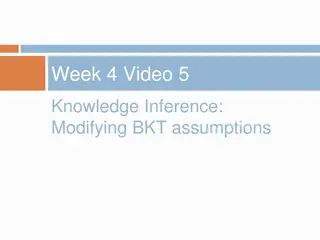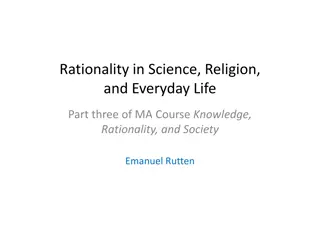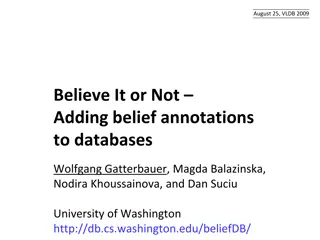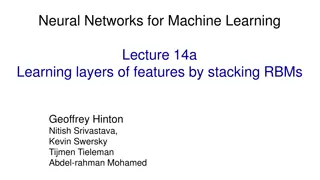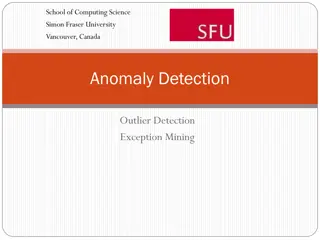Understanding Bayesian Belief Networks for AI Applications
Bayesian Belief Networks (BBNs) provide a powerful framework for reasoning with probabilistic relationships among variables, offering applications in AI such as diagnosis, expert systems, planning, and learning. This technology involves nodes representing variables and links showing influences, allowing computation of probabilities based on evidence. The Bayes Rule facilitates the calculation of conditional probabilities, and examples like a simple Bayesian network illustrate the concept's practical use. More complex networks extend to diverse variables like age, gender, and exposure to toxins, demonstrating the broad applicability of BBNs in data analysis and decision-making.
Download Presentation

Please find below an Image/Link to download the presentation.
The content on the website is provided AS IS for your information and personal use only. It may not be sold, licensed, or shared on other websites without obtaining consent from the author. Download presentation by click this link. If you encounter any issues during the download, it is possible that the publisher has removed the file from their server.
E N D
Presentation Transcript
Reasoning with Bayesian Belief Networks
Overview Bayesian Belief Networks (BBNs) can reason with networks of propositions and associated probabilities Useful for many AI problems Diagnosis Expert systems Planning Learning
BBN Definition AKA Bayesian Network, Bayes Net A graphical model (as a DAG) of probabilistic relationships among a set of random variables Nodes are variables, links represent direct influence of one variable on another Nodes have associated prior probabilities or Conditional Proability Tables (CPTs) source
Recall Bayes Rule = = ( , ) ( | ) ( ) ( | ) ( ) P H E P H E P E P E H P H ( | P ) ( ) P E H P H = ( | ) P H E ( ) E Note symmetry: can compute probability of a hypothesis given its evidence as well as probability of evidence given hypothesis
Simple Bayesian Network , , S no light heavy Smoking Cancer , , C none benign malignant
Simple Bayesian Network , , S no light heavy Smoking Cancer , , C none benign malignant Nodes represent variables Links represent causal relations
Simple Bayesian Network , , S no light heavy Smoking Cancer , , C none benign malignant Prior probability of S P(S=no) P(S=light) P(S=heavy) 0.05 0.80 0.15 Nodes with no in-links have prior probabilities Joint distribution of S and C Smoking= no C=none C=benign C=malignant 0.01 0.04 light heavy 0.60 0.25 0.15 Nodes with in-links have joint probability distributions 0.96 0.88 0.03 0.08
More Complex Bayesian Network Age Gender Exposure to Toxics Smoking Cancer Serum Calcium Lung Tumor
More Complex Bayesian Network Nodes represent variables Age Gender Exposure to Toxics Smoking Does gender cause smoking? Links represent causal relations Cancer Influence might be a better term Serum Calcium Lung Tumor
More Complex Bayesian Network Age Gender Exposure to Toxics Smoking condition Cancer Serum Calcium Lung Tumor
More Complex Bayesian Network predispositions Age Gender Exposure to Toxics Smoking Cancer Serum Calcium Lung Tumor
More Complex Bayesian Network Age Gender Exposure to Toxics Smoking Cancer observable symptoms Serum Calcium Lung Tumor
More Complex Bayesian Network Model has 7 variables Complete joint probability distribution will have 7 dimensions! Too much data required BBN simplifies: a node has a CPT with data on itself & parents in graph Age Gender Can we predict likelihood of lung tumor given values of other 6 variables? Exposure to Toxics Smoking Cancer Serum Calcium Lung Tumor
Independence Age and Gender are independent. Age Gender P(A,G) = P(G) * P(A) There is no path between them in the graph P(A |G) = P(A) P(G |A) = P(G) P(A,G) = P(G|A) P(A) = P(G)P(A) P(A,G) = P(A|G) P(G) = P(A)P(G)
Conditional Independence Cancer is independent of Age and Gender given Smoking Age Gender Smoking P(C | A,G,S) = P(C | S) Cancer If we know value of smoking, no need to know values of age or gender
Conditional Independence Cancer is independent of Age and Gender given Smoking Age Gender Instead of one big CPT with 4 variables, we have two smaller CPTs with 3 and 2 variables Smoking If all variables binary: 12 models (23 +22) rather than 16 (24) Cancer
Conditional Independence: Nave Bayes Serum Calcium and Lung Tumor are dependent Cancer Serum Calcium is indepen- dent of Lung Tumor, given Cancer Serum Calcium Lung Tumor P(L | SC,C) = P(L|C) P(SC | L,C) = P(SC|C) Na ve Bayes assumption: evidence (e.g., symptoms) independent given disease; easy to combine evidence
Explaining Away Exposure to Toxics and Smoking are independent Exposure to Toxics Smoking Exposure to Toxics is dependent on Smoking, given Cancer Cancer P(E=heavy | C=malignant) > P(E=heavy | C=malignant, S=heavy) Explaining away: reasoning pattern where confirma- tion of one cause reduces need to invoke alternatives Essence of Occam s Razor (prefer hypothesis with fewest assumptions) Relies on independence of causes
Conditional Independence A variable (node) is conditionally independent of its non-descendants given its parents Age Gender Non-Descendants Exposure to Toxics Smoking Parents Cancer is independent of Age and Gender given Exposure to Toxics and Smoking. Cancer Serum Calcium Lung Tumor Descendants
Another non-descendant A variable is conditionally independent of its non-descendants given its parents Age Gender Exposure to Toxics Smoking Cancer Cancer is independent of Diet given Exposure to Toxics and Smoking Diet Serum Calcium Lung Tumor
BBN Construction The knowledge acquisition process for a BBN involves three steps KA1: Choosing appropriate variables KA2: Deciding on the network structure KA3: Obtaining data for the conditional probability tables
KA1: Choosing variables Variable values: integers, reals or enumerations Variable should have collectively exhaustive, mutually exclusive values Error Occurred x x x x 1 x 2 3 i 4 No Error ( ) x j i j They should be values, not probabilities Risk of Smoking Smoking
Heuristic: Knowable in Principle Example of good variables Weather: {Sunny, Cloudy, Rain, Snow} Gasoline: Cents per gallon {0,1,2 } Temperature: { 100 F , < 100 F} User needs help on Excel Charts: {Yes, No} User s personality: {dominant, submissive}
KA2: Structuring Age Gender Network structure corresponding to causality is usually good. Exposure to Toxic Smoking Genetic Damage Cancer Initially this uses the designer s knowledge but can be checked with data Lung Tumor
KA3: The Numbers For each variable we have a table of probability of its value for values of its parents For variables w/o parents, we have prior probabilities , , S C no none light , heavy Smoking Cancer , benign malignant smoking light smoking priors cancer no heavy no 0.80 none 0.96 0.88 0.60 light 0.15 benign 0.03 0.08 0.25 heavy 0.05 malignant 0.01 0.04 0.15
KA3: The numbers Second decimal usually doesn t matter Relative probabilities are important Zeros and ones are often enough Order of magnitude is typical: 10-9 vs 10-6 Sensitivity analysis can be used to decide accuracy needed
Three kinds of reasoning BBNs support three main kinds of reasoning: Predicting conditions given predispositions Diagnosing conditions given symptoms (and predisposing) Explaining a condition by one or more predispositions To which we can add a fourth: Deciding on an action based on probabilities of the conditions
Predictive Inference Age Gender How likely are elderly males to get malignant cancer? Exposure to Toxics Smoking P(C=malignant | Age>60, Gender=male) Cancer Serum Calcium Lung Tumor
Predictive and diagnostic combined How likely is an elderly male patient with high Serum Calcium to have malignant cancer? Age Gender Exposure to Toxics Smoking P(C=malignant | Age>60, Gender= male, Serum Calcium = high) Cancer Serum Calcium Lung Tumor
Explaining away Age Gender If we see a lung tumor, the probability of heavy smoking and of exposure to toxics both go up Exposure to Toxics Smoking Smoking If we then observe heavy smoking, the probability of exposure to toxics goes back down Cancer Serum Calcium Lung Tumor
Decision making A decision is a medical domain might be a choice of treatment (e.g., radiation or chemotherapy) Decisions should be made to maximize expected utility View decision making in terms of Beliefs/Uncertainties Alternatives/Decisions Objectives/Utilities
Decision Problem Should I have my party inside or outside? dry Regret in wet Relieved dry Perfect! out wet Disaster
Value Function A numerical score over all possible states allows a BBN to be used to make decisions Location? Weather? in in out out Value $50 $60 $100 $0 dry wet dry wet Using $ for the value helps our intuition
Some software tools Netica: Windows app for working with Bayes- ian belief networks and influence diagrams A commercial product, free for small networks Includes graphical editor, compiler, inference engine, etc. Hugin: free demo version for linux, mac, windows is available
Symptoms or effects Dyspnea is shortness of breath
Decision Making with BBNs Today s weather forecast might be either sunny, cloudy or rainy Should you take an umbrella when you leave? Your decision depends only on the forecast The forecast depends on the actual weather Your satisfaction depends on your decision and the weather Assign a utility to each of four situations: (rain|no rain) x (umbrella, no umbrella)
Decision Making with BBNs Extend BBN framework to include two new kinds of nodes: decision and utility Decision node computes the expected utility of a decision given its parent(s) (e.g., forecast) and a valuation Utility node computes utility value given its parents, e.g. a decision and weather Assign utility to each situations: (rain|no rain) x (umbrella, no umbrella) Utility value assigned to each is probably subjective
